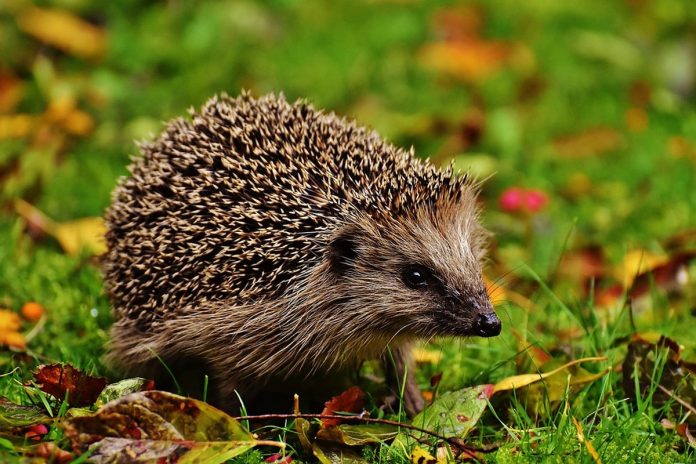A family of hedgehogs has made a home in one of the solariums of the Buzau Research and Development Station for Vegetables (SCDL), the specialists making the decision to keep the small animals considering the benefit the bring to the garden, write Agerpres.
The encounter with one of the hedgehogs took place one morning, when the SCDL researchers, according to the schedule, were going to visit the greenhouses and solariums to observe the state of the cultivated plants. A few days later, the employees of the resort would discover that in fact two other baby hedgehogs were in one of the tomato greenhouses, where the drip storms were moved.
„The encounter took place on Friday morning (last week, ed. n.), when, as always, I was making my daily visit to the solariums. I was making some observations regarding the phenology of tomatoes, when, on the foil in the solarium, a few rows away from me, I heard a noise, I approached and saw that a hedgehog was walking slowly. Being the first time I saw a hedgehog so close, I was delighted by his tenderness, and still looking at him I noticed that he had two ticks on his nose. Therefore, I called my colleagues for help and took the hedgehog to the laboratory, where the two ticks were removed. Then I released him into the field among our perennial crops, knowing that the hedgehog is a priceless treasure in a garden. Monday morning, in the greenhouse where I was doing the data retrieval routine, I noticed that the drip storms were moved, we wanted to arrange them and it was almost like stepping on … hedgehogs, only this time, there were two babies. The hedgehogs have also had a bed made of some tomato plants that I had given away last week. Because we fell in love with them, we couldn’t help not do a photo session of them,” Elena Barcanu, a researcher at the Vegetable Station, told AGERPRES.
Because hedgehogs are considered important for the health of a vegetable garden, the researchers decided that the guests should continue to stay in the place where they made their shelter.
„In our solariums, besides the consecrated vegetables, there are also many snails, mice, many ants that carry on their backs the aphids that give them honey, only that they harm our crops, but also other pests that are not at all friendly to our plants. More exactly, a paradise for hedgehogs! The other day I caught the mother hedgehog eating ant eggs. I saw that she likes it in our greenhouse, so we don’t move her, we just have to be very careful where we step,” the researcher from SCDL Buzau also specified.
Then, she listed the benefits brought by the presence of hedgehogs among crops.
„Among the benefits of a family of hedgehogs: pest control. Hedgehogs are known to prey on common garden pests such as insects, snails and slugs. These small mammals feed on these harmful organisms and can help maintain an ecological balance in the garden. Pollination: Hedgehogs can play an important role in plant pollination. As they move through the garden, they can carry pollen from one flower to another, contributing to the reproduction of flowering plants and the formation of fruits and seeds. Aeration of the soil: Hedgehogs can help aerate the soil through their digging and foraging activity. Through digging and regular movements, they can contribute to mixing the soil and increasing its permeability, which favours the penetration of water and oxygen into the plant roots. Rodent control: Hedgehogs can also play a role in rodent control in the garden. They feed on mice, rats and other small rodents that can be harmful to plants and crops,” Elena Barcanu explained.
According to specialists, hedgehogs also play an important role in ecological diversity, their presence in the garden attracting other species of animals that can benefit from the same favorable habitat conditions. The Station’s researchers recommend that vegetable growers take into account a series of tips that could help them so that crops are protected from pests, and the products they market or consume are healthy.
„Adopting preventive cultural practices to reduce the risk of pests – these may include crop rotation, avoiding plant overcrowding, maintaining a healthy and balanced soil, using compost and organic fertilizers, adequate watering and irrigation and ensuring ventilation (in cases in which it is grown in protected spaces). It is important to correctly identify the pests that affect the garden.The use of companion plants: companion species are those plants that are planted together to provide mutual benefits. Some plants may release natural chemicals that repel pests, others may attract beneficial insects that feed on the pests. One can opt for biological control methods, which involve the use of other organisms to control pests. Beneficial insects such as parasitic wasps, spiders, birds and small rodents can be introduced into the garden to control pests. Also, beneficial bacteria, fungi or nematodes can be used to combat certain problems,” Elena Barcanu emphasised.
The Research and Development Station for Vegetable Crops Buzau recommends the use of pesticides with caution and regular monitoring of the garden, which has the role of early detection of signs of pests or diseases. The earlier problems are noticed, the more efficiently and quickly interventions can be made.




